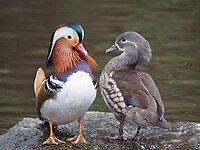
Anthropometric measures do not explain the 2D:4D ratio sexual dimorphism in 7‐year‐old children
Sign Up to like & getrecommendations! Published in 2022 at "American Journal of Human Biology"
DOI: 10.1002/ajhb.23776
Abstract: Digit ratio (2D:4D) might reflect prenatal testosterone exposure and has been used as a putative marker for androgen related outcomes. However, such associations might be inflicted by confounders. Application of 2D:4D in epidemiological research motivate… read more here.
Keywords: ratio sexual; anthropometric measures; measures explain; explain ratio ... See more keywords

No evidence of sexual dimorphism in the tails of the swallowtail butterflies Papilio machaon gorganus and P. m. britannicus
Sign Up to like & getrecommendations! Published in 2021 at "Ecology and Evolution"
DOI: 10.1002/ece3.7374
Abstract: Abstract The European swallowtail butterfly (Papilio machaon) is so named, because of the long and narrow prominences extending from the trailing edge of their hindwings and, although not a true tail, they are referred to… read more here.
Keywords: tail length; papilio machaon; size; tail ... See more keywords

Sexual dimorphism as a facilitator of worker caste evolution in ants
Sign Up to like & getrecommendations! Published in 2023 at "Ecology and Evolution"
DOI: 10.1002/ece3.9825
Abstract: Abstract Ant societies are primarily composed of females, whereby labor is divided into reproductive, or queen, and non‐reproductive, or worker, castes. Workers and reproductive queens can differ greatly in behavior, longevity, physiology, and morphology, but… read more here.
Keywords: worker; variation; worker caste; dimorphism ... See more keywords

Allometry in the corpus callosum in neonates: Sexual dimorphism
Sign Up to like & getrecommendations! Published in 2022 at "Human Brain Mapping"
DOI: 10.1002/hbm.25977
Abstract: The corpus callosum (CC) is the largest fiber tract in the human brain, allowing interhemispheric communication by connecting homologous areas of the two cerebral hemispheres. In adults, CC size shows a robust allometric relationship with… read more here.
Keywords: size; corpus callosum; sexual dimorphism; brain size ... See more keywords

Sexual dimorphism in hepatic lipids is associated with the evolution of metabolic status in mice
Sign Up to like & getrecommendations! Published in 2017 at "NMR in Biomedicine"
DOI: 10.1002/nbm.3761
Abstract: Ectopic lipid accumulation in the liver is implicated in metabolic disease in an age‐ and sex‐dependent manner. The role of hepatic lipids has been well established within the scope of metabolic insults in mice, but… read more here.
Keywords: lipids associated; hepatic lipids; months months; sexual dimorphism ... See more keywords

Sexual dimorphism in cardiac remodeling: the molecular mechanisms ruled by sex hormones in the heart.
Sign Up to like & getrecommendations! Published in 2021 at "Journal of molecular medicine"
DOI: 10.1007/s00109-021-02169-w
Abstract: Heart failure (HF) is growing in prevalence, due to an increase in aging and comorbidities. Heart failure with reduced ejection fraction (HFrEF) is more common in men, whereas heart failure with preserved ejection fraction (HFpEF)… read more here.
Keywords: heart; heart failure; sex; molecular mechanisms ... See more keywords

The Role of Sexual Dimorphism and Tissue Selection in Ecotoxicological Studies Using the Riparian Spider Tetragnatha elongata
Sign Up to like & getrecommendations! Published in 2019 at "Bulletin of Environmental Contamination and Toxicology"
DOI: 10.1007/s00128-019-02632-y
Abstract: Tetragnathid spiders (Tetragnatha spp.) found in riparian habitats have recently been used as bioindicators of sediment contamination and insect-mediated contaminant flux. We investigated whether sexual dimorphism (size and behavior) influenced the female:male ratio in composite… read more here.
Keywords: dimorphism tissue; spider; dimorphism; role sexual ... See more keywords

Sex-dependent dynamics of metabolism in primary mouse hepatocytes
Sign Up to like & getrecommendations! Published in 2021 at "Archives of Toxicology"
DOI: 10.1007/s00204-021-03118-9
Abstract: The liver is one of the most sexually dimorphic organs. The hepatic metabolic pathways that are subject to sexual dimorphism include xenobiotic, amino acid and lipid metabolism. Non-alcoholic fatty liver disease and hepatocellular carcinoma are… read more here.
Keywords: metabolism; male female; sex dependent; sex ... See more keywords

Sexual dimorphism in maternally separated rats: effects of repeated homotypic stress on gastrointestinal motor functions.
Sign Up to like & getrecommendations! Published in 2021 at "Experimental brain research"
DOI: 10.1007/s00221-021-06151-3
Abstract: Experiencing stressful events during early life has been considered as a risk factor for development of functional gastrointestinal disorders in adulthood. This study aimed to investigate the sex-related differences in stress-induced gastrointestinal (GI) dysmotility in… read more here.
Keywords: homotypic stress; repeated homotypic; stress; sexual dimorphism ... See more keywords

Investigating sexual dimorphism in human brain structure by combining multiple indexes of brain morphology and source-based morphometry
Sign Up to like & getrecommendations! Published in 2021 at "Brain Structure and Function"
DOI: 10.1007/s00429-021-02376-8
Abstract: Computational morphometry of magnetic resonance images represents a powerful tool for studying macroscopic differences in human brains. In the present study ( N participants = 829), we combined different techniques and measures of brain morphology to investigate… read more here.
Keywords: morphometry; brain structure; sexual dimorphism; brain morphology ... See more keywords

Does sexual dimorphism predispose dioecious riparian trees to sex ratio imbalances under climate change?
Sign Up to like & getrecommendations! Published in 2018 at "Oecologia"
DOI: 10.1007/s00442-018-4190-7
Abstract: Environmental changes have resulted in significant declines in native riparian forests that are comprised largely of dioecious tree taxa, including boxelder and iconic cottonwood/willow gallery forests. Dioecious species may be especially vulnerable to the effects… read more here.
Keywords: sexual dimorphism; sex ratio; climate change; dioecious riparian ... See more keywords